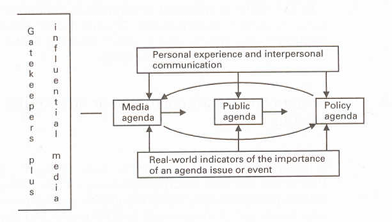“Through this
process many people have to decide whether or not the news is to be seen or
heard. Some gatekeepers might include reporters, writers, and editors. After
gatekeeping comes agenda setting."(Wilson, 2005).
The initial
process of gatekeeping starts with what has been previously discussed here – it
starts with news values. However –without agenda – news cannot exist. It is
this agenda that gives news meaning, relevance and importance within society.
It has been said
that ‘the press and the media do not reflect reality; they filter and shape
it’. There are four types of agenda that
shapes our news:
- PUBLIC AGENDA – topics that members of the public deem to be important.
- POLICY AGENDA - topics that decision makers think are significant. (E.g. politicians)
- CORPORATE AGENDA – topics that influential companies or corporate bodies deem important.
- MEDIA AGENDA - topics discussed in media.
These
agendas are all connected with each other, as topics frequently fit into some
or all of the above agenda categories. Agendas
dictate how and why the media presents news.
McCombs and Shaw conducted an integral study in 1968, when
they decided to investigate agenda setting in mass media. At the time an
American presidential campaign was taking place – so they decided to look at
what the voters thought were important issues in the campaign, comparatively to
what content the media was producing. After speaking to 100 undecided voters
about their opinions, it became evident that the majority of their sample’s
opinions were a result of (or could be related back to) how the mass media had
portrayed topics in the news. If we apply these findings to the wider
population, this study shows how the media really has the power to shape the
opinions of its audience.
 |
| Welles unknowingly created widespread panic in 1938. |
Other factors of agenda setting include ‘cutting’, ‘surfing’, diffusion,
portrayal and media reliance. The media decide what is newsworthy – the media
essentially chooses what our news is. This is cutting. Media outlets use
‘surfing’ – this is when media concentrates on popular or on-trend issues.
Diffusion refers to when and how the media is released, and by whom. Portrayal
refers to how an issue is depicted in the media, and media dependence is how
much one is affected by media agenda. The more one actively seeks information
through specific types of media, the more likely it is that that person will be
susceptible to whatever agenda is decided by that media outlet.
There are some problems with agenda setting, such as the hypodermic
needle theory, in which the audience is just a blank canvas that accepts all
information provided by media. A good example of this is when Orson Welles
preformed his radio show of ‘War Of The Worlds in 1938. One million Americans heard
the broadcast radio play and believed that aliens were actually invading the
earth. People panicked, raided grocery stores, fled and started to ration food.
Media Outlets have a range of tools at their fingertips, which shape how
the public views an issue. News values paired with a range of tactics that is
agenda setting can result in a variety of responses to a particular topic. For
example, one publication can have their audience thinking one thing whereas
another publication can have an entirely opposite point of view about the same
topic. The audience we must be careful and be aware of how the media portrays
certain topics in certain ways and why they do this – otherwise we can find
ourselves with opinions that we aren’t really sure how they were formed to
begin with.
References:
http://en.wikipedia.org/wiki/Agenda-setting_theory
http://www.utwente.nl/cw/theorieenoverzicht/Theory%20Clusters/Mass%20Media/Agenda-Setting_Theory.doc/
http://www.utwente.nl/cw/theorieenoverzicht/Theory%20Clusters/Mass%20Media/Hypodermic_Needle_Theory.doc/index.html

No comments:
Post a Comment